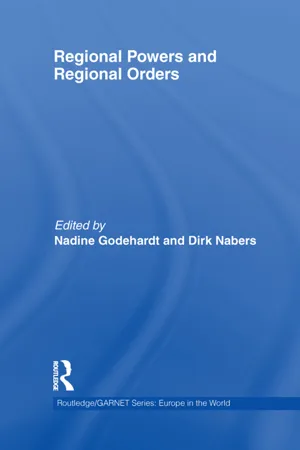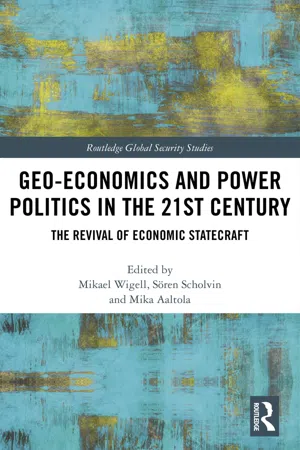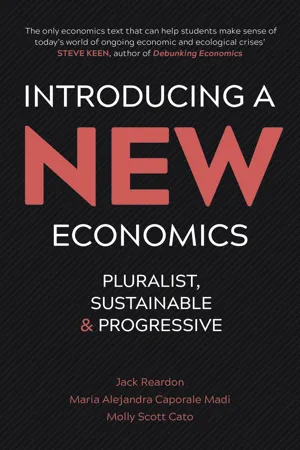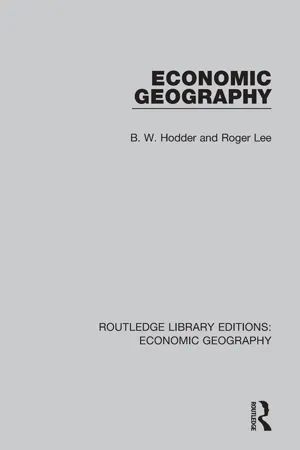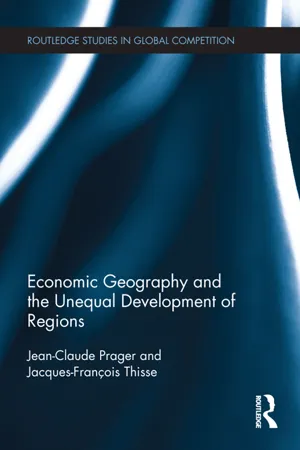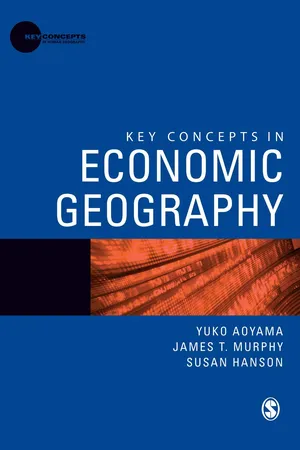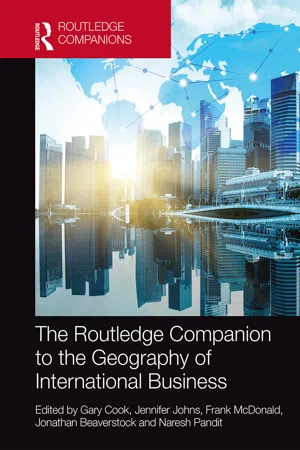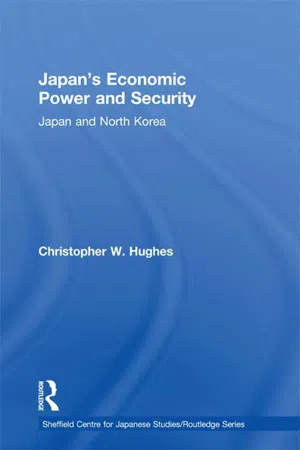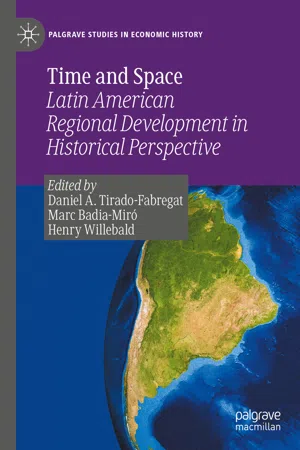Geography
Economic Power
Economic power refers to the ability of a country or region to influence and control the global economy through its production, trade, and financial resources. It is often measured by indicators such as GDP, trade volume, and foreign investment. Economic power can shape geopolitical relationships and impact the distribution of wealth and resources on a global scale.
Written by Perlego with AI-assistance
Related key terms
10 Key excerpts on "Economic Power"
- eBook - ePub
- Nadine Godehardt, Dirk Nabers(Authors)
- 2011(Publication Date)
- Routledge(Publisher)
Size alone (of a country or of a company) is not adequate; also necessary are ‘intelligence, readiness to respond, and efficiency in translating decisions into action’ (Kindleberger 1970 : 56). Based on this, Kindleberger defines power as follows: ‘Power is the strength plus the capacity to use it effectively’ (Kindleberger 1970 : 65). According to Kindleberger, the exercise of power includes a nation’s display of economic productivity and mobility. The advantage for the leadership is being the first to enjoy the fruits of research, which in turn gives the leader the capacity to transform. Kindleberger’s contribution on regional power is therefore characterized by the terms public goods and capacity to transform, with which the relational dynamics of these interconnections are highlighted. Susan Strange (1975) bases her structural power concept on the heterodox perspective of international political economy. She assumes the power of states and the role of transnationally active Non-Governmental Organizations. According to her concept, Economic Power is exercised on four levels (Strange 1975 : 222). Rich countries and their governments influence the structure of the global economy through the pattern of their investments, production, trade and consumption. They establish the framework for minimum standards for the maintenance of stability, order and law in the global market economy. National governments exercise Economic Power through the formulation of national laws (for factors of production, credit and markets). The government with the biggest domestic market and the largest number of multinational businesses (that are important in the driving of global production) possesses the greatest Economic Power. Buyers and sellers, creditors, and debtors affect economic transactions at the operational level. Economic Power is thus always the result of a bargaining process; that is, it is relational. Technology and hegemony According to Richard R - eBook - ePub
Geo-economics and Power Politics in the 21st Century
The Revival of Economic Statecraft
- Mikael Wigell, Sören Scholvin, Mika Aaltola, Mikael Wigell, Sören Scholvin, Mika Aaltola(Authors)
- 2018(Publication Date)
- Routledge(Publisher)
Blackwill and Harris fail to properly explain the geo-dimension, too. They try to distinguish between geo-economics and geopolitics, arguing that the latter ‘explain[s] and predict[s] state power by reference to a host of geographic factors (territory, population, economic performance, natural resources, military capabilities, etc.)’. Geo-economics, meanwhile, is ‘a parallel account of how a state builds and exercises power by reference to economic factors’ (2016, p. 24). First, economic factors somewhat confusingly appear in both definitions. What is more, economic performance and military capabilities are not geographical factors. Unless one maintains that everything is geographical because everything is located somewhere, geographical factors are limited to place-specific features – a mountain range that serves as a natural barrier against military invasions, or vast energy resources that constitute the fundament for economic prosperity, for instance. Whenever such factors are taken into consideration in explanations of foreign policy and international relations, it can reasonably be argued that geo-economics and geopolitics (instead of economics and politics) are analysed. Before returning to these thoughts, the next section provides an overview of approaches to geo-economics that do not stand in the Luttwakian tradition.Non-Luttwakian approaches to geo-economics
Some publications that may run under the label of geo-economics are much less related to power politics than Luttwak’s own work, or not at all. Scholvin and Draper (2012), as well as Scholvin and Malamud (2014), concentrate on the impact of material structures in the geographical space on Brazil’s and South Africa’s respective regional economic relations. Käpylä and Mikkola (2016) explain that geographical conditions induce states to cooperate in the Arctic, because open confrontation would risk everyone’s economic objectives. As a side note, this concept of geo-economics – geographical conditions shaping economic outcomes – equals the understanding of geopolitics historically held by geographers, who thought of geopolitics as political outcomes shaped by geographical conditions (Scholvin 2016).Others relate geo-economics to the rise of new actors that matter for economic and political dynamics beyond the national scale. For instance, Barton (1999) argues that while the era of geopolitics was about hegemonic states and stability in international relations, the era of geo-economics is marked by highly flexible non-state actors and borderless transnational relations. Mercille (2008) suggests that while businesspeople act according to a geo-economic logic, the logic behind the actions of politicians is geopolitical. From a slightly different perspective, Cowen and Smith (2009) suggest that the assemblage of territory, economy and people under the authority of nation-states – key criteria of the era of geopolitics – is being recast, mainly because territorial borders have lost the defining role they used to play for the economy and society. The era of geo-economics is marked by global production being more and more segmented, which comes along with the rise of transnational enterprises as key actors. Security threats such as terrorism are also not bound to territorial borders. - eBook - ePub
Introducing a New Economics
Pluralist, Sustainable and Progressive
- Jack Reardon, Maria Alejandra Caporale Madi, Molly Scott Cato(Authors)
- 2017(Publication Date)
- Pluto Press(Publisher)
power . This chapter examines how power is defined and exercised in the economy. It concludes with a brief look at impending water shortages, which not only underscores the interrelatedness of climate change, population growth, carbon emissions and unsustainable agriculture but also highlights the importance and ubiquity of power in determining solutions. Who owns access to the resources? What is the power configuration? How is this supported by the underlying institutions? What is an equitable price? What are the most effective institutions to ensure adequate access for all?4.1 UNDERSTANDING POWER IN AN ECONOMIC CONTEXT
Power is an important concept and is a central aspect of just about everything that happens in our economy. Ascertaining the sources of power, how power is obtained, how it is used and its effects are important objectives of a thorough study of economics. Power is a multifaceted word, much like democracy, sustainability and pluralism – rich in meaning, yet hard to define. Nevertheless, a good working definition that we like and will use in this text is offered by Benn (1967a: 426):Power is the generalised potentiality for getting one’s own way or for bringing about changes (at least some of which are intended) in other people’s actions or conditions.Given the importance of power in economics, and its ubiquity in economic systems, let’s take a few moments to dissect this definition into its constituent components:• Power is contextual: it involves a specific time, place and actors. Change the time and place, and most likely the initial configuration of power no longer exists.• Power is relational: that is, power occurs between two or more parties.In a relational context of power, the two (or more) parties are unequal: the stimulator possesses advantages which are contextual vis-à-vis the reactor, i.e. ‘power generally implies a difference of standing between the two parties: the one stimulates and the other reacts’ (Ibid.: 424). Given unequal advantage, a conflict of interest exists between the stimulator and the reactor, so that the latter acquiesces to the wishes of the former even if against the reactor’s wishes. In fact, one person forcing another to act contrary to the other’s wishes in order to enforce one’s will is the essence of power. - eBook - ePub
- James T. Tedeschi(Author)
- 2017(Publication Date)
- Routledge(Publisher)
Economic activity includes all activity rationally designed to achieve human objectives when faced by the niggardliness of nature, that is, by the scarcity of material or human resources. It is therefore contrasted with political activity which includes all activity designed to achieve group objectives when faced by the opposition of other groups. Scarcity is the essence of economics as opposition is of politics. In economics, the problem is to overcome obstructions to achievement arising from physical nature, in politics to overcome obstructions arising from human nature(Wright 1955, p. 237).Wright's definition of the two spheres not only distinguishes between them, but also makes it clear that both are concerned with overcoming resistance. Wright goes on to spell out the interdependency between politics and economics:A shortage of resources leads to competition between different persons or groups to obtain them and this may lead to rivalry, conflict, and political activity by each to overcome the obstruction offered by others to attaining its objectives. Conversely, a group may persuade an opposing group to yield to its demands by offering economic rewards or withholding economic advantages. Economics may therefore be an instrument of politics.(Wright 1955, p. 239).Alternative Concepts of Economic Power
The term Economic Power tends to be used rather loosely, as is indicated by a review of some common meanings.(1) Productive power. Perhaps the most common meaning of Economic Power is ability to produce goods and services in a given time period. For a nation gross national product (GNP) would be the equivalent term, while for an individual the equivalent term would be earning power.(2) Productive power relative to need. A refinement of the above concept relates productive capacity to need. Thus, one might encounter the statement that John, with two children and a $15,000 annual income, has more Economic Power than Tom, who has the same income but eight children. In international relations per capita GNP would be the counterpart of this example. Although India and Canada have about the same GNP, Canada has only 20 million mouths to feed, while India has 500 nillion. Therefore, many people would not regard them as equal in Economic Power.(3) Growth rate. - eBook - ePub
- B. W. Hodder, Roger Lee(Authors)
- 2015(Publication Date)
- Routledge(Publisher)
Finally, the concept of the economy underlies the logic of the discussion in the sections that follow. The next chapter presents a selective review of literature in the field of economic geography against the background of the concept of the economy developed so far. Then follows the second and longer section of the book in which there is a discussion of the mechanisms of decision making and control. This involves a study of demand, supply, price and the market mechanisms; the alternative or complementary role of government control; and the decision-making activities of consumers, firms and resource owners. The third section of the book takes a closer look at the physical expression of integration within and between economies in the form of flows of goods, people and ideas, and the spatial structure of market centres and transport networks. The final section is devoted to a brief review of the geography of economic growth and development. This is a rapidly growing field of applied economic geography and demonstrates the apparent inability or unwillingness of the world economy to redistribute Economic Power or wealth from the rich to the poor. Intolerable economic inequalities, whether structural or spatial, and the associated ecological implications of the great but highly concentrated productive power of the world economy are perhaps the two major problems facing mankind.Passage contains an image
2 Geographical studies of economic activityThe concept of the economy has rarely been used explicitly in geographical studies of economic activity; economic geography, in general, has been concerned with matters other than the operation of economies, the behaviour and interaction of their elements or the implications of the prevailing distribution of Economic Power. Within the existing literature in economic geography it is possible to distinguish two overlapping approaches to the study of economic activity. Systematic approaches are normally defined in terms of specific products (e.g. wheat), sectors (e.g. energy) or processes (e.g. trade), and are concerned with the spatial structure of these phenomena. Spatial approaches are defined in terms of specific two-dimensional, abstract, national or regional space and are concerned with the spatial structure of economic activity within these areas and with the effects of economic activity upon their economic and regional character.Systematic approaches
An early emphasis in economic geography was upon the scientific study of world areas in their direct influence upon the production of goods (Götz 1882). This approach sought to lay bare the influence of the natural environment upon the occupations, products and lives of people in different regions of the world (Wooldridge and East 1966). The best-known example of this approach is Chisholm’s handbook of commercial geography - Jean-Claude Prager, Jacques-François Thisse(Authors)
- 2012(Publication Date)
- Routledge(Publisher)
2 Economic geography
Facts and theories
The shaping of the space-economy
High population density fosters the division of labor
What are the main geographical forces that affect the economic and social development of a given region or country? The first was identified by Adam Smith more than two centuries ago: “the extent of the division of labor is limited by the size of the market.” The market is defined here as the range of customers that producers can supply through existing transport technologies. This suggests that the high population density prevailing in cities allows a degree of task specialization that is not found in rural areas, since such density ensures that there will be outlets to support local craftsmen and workshops. To a large extent, city dwellers produce neither the food they eat nor the energy they consume. In exchange for the farm products and energy they need, they must therefore supply goods and services that are not produced in rural areas. The production of such commodities requires greater task specialization than is typically found in the countryside.In addition, a city is its own primary outlet, since the inhabitants consume a high proportion of the goods and services produced there. In other words, the city itself is the main component of its market. This observation is relevant because most services are by nature non-transportable and must be consumed where they are produced. Since the export base often accounts for only a small share of a city’s activities, local services are a crucial factor in urban growth.To justify acquisition of the skills required for such task specialization, cities and their hinterlands must therefore be of a certain size. To put it simply, a sufficiently large and relatively concentrated population is needed. Once this condition has been met, a finer division of labor generates an urban surplus that can be shipped to the city’s rural hinterland and sometimes to other cities specializing in the production of different goods. The combination of these two forces generates surpluses of various natures and origins, which in turn are traded between the rural and urban populations. In most cases, this process has been slow because it is subject to many contingencies: these surpluses leave the subsistence economy and enter the trade economy, which requires much more complex institutions than those of the rural community, especially the use of money.- eBook - ePub
- Yuko Aoyama, James T Murphy, Susan Hanson(Authors)
- 2010(Publication Date)
- SAGE Publications Ltd(Publisher)
Section 4Global Economic Geographies
How do economic geographers conceptualize economic processes at the global scale? In Section 4 the focus shifts from the local and regional to key concepts that are essential to analyzing Global Economic Geographies.How do economic geographers engage in globalization debates? As economic geographers are concerned with generalizable theory as well as specific contexts, the approach is necessarily multi-faceted. The chapter on Core–Periphery draws heavily on Marxist ideas, especially dependency theory and world-system theories, to explain how uneven economic development at the global scale is sustained in part by political-economic relationships between wealthy (i.e. core), emerging (i.e. semi-peripheral) and poor (i.e. peripheral) countries. Core economies, through colonization and imperialism and, more recently, neo-liberal and information-driven capitalism, have created uneven structural relationships with those in peripheral and semi-peripheral countries. These relationships enable the core to extract surplus value and maintain global economic dominance, while making it difficult for those in the periphery and semi-periphery to improve their economic and geopolitical position in the world system.The chapter on Globalization focuses on three aspects of economic globalization. The first is the role of MNCs in driving various forms (e.g. offshoring, outsourcing), which in turn result in a new International Division of Labour. We then discuss how globalization’s interconnecting and homogenizing tendencies are limited by factors such as localized, place-specific knowledge, state actors, and cultural preferences and traditions. Finally, we explore the concept of scale under globalization, noting that traditional perspectives on scale (i.e. local, regional, national and global) are losing their usefulness for analyzing both local development and global economic change. - Gary Cook, Jennifer Johns, Frank McDonald, Jonathan Beaverstock, Naresh Pandit, Gary Cook, Jennifer Johns, Frank McDonald, Jonathan Beaverstock, Naresh Pandit(Authors)
- 2018(Publication Date)
- Routledge(Publisher)
p.175 PART III The interface between Economic Geography and International Business p.177 11 ECONOMIC GEOGRAPHY AND INTERNATIONAL BUSINESS Henry Wai-chung Yeung Introduction The development and emergence of economic-geographical studies of International Business activities is an important topic. As these cross-border intra- and inter-firm activities are becoming more globally interconnected and interdependent today, their management and governance by firms, states and other institutions is much more challenging and complex. The geographical foundations and specificities of this phenomenon in a globalizing era has become a crucial research question for the academic fields of Economic Geography and International Business studies. Indeed, both fields are nested within the larger disciplines – respectively in human geography and in strategy and management studies. Both fields are primarily concerned with descriptions and explanations of real-world economic phenomena in the world. There is thus much commonality between Economic Geography and International Business studies. In this chapter, I focus on two key issues that speak well to the interface between Economic Geography and International Business studies: (1) the geographical nature of International Business and (2) the theorization of spatiality in International Business studies. The first issue is fairly obvious in a global economy characterized by densely interconnected networks of firms and economies operating at different geographical scales. In short, there are clearly visible geographical foundations to International Business activities (Yeung, 2005a, 2009a). While the role of physical location and distance has been conceptualized in some leading theoretical perspectives in International Business studies (e.g. Dunning, 1998, 2009; Buckley & Ghauri, 2004), the nature of spatiality entails much more than location as a production factor, an agglomeration economy, or a competitive advantage- eBook - ePub
Japan's Economic Power and Security
Japan and North Korea
- Christopher W. Hughes(Author)
- 2013(Publication Date)
- Routledge(Publisher)
If a state is to conform to the model of global civilian power, arguably it needs to possess three indispensable qualities which are discussed next: conception, capacity, and policy-making will. The first quality of conception is concerned with the ability of a state to look beyond military power and to perceive the opportunities presented to it to handle a particular security threat by means of Economic Power. The second quality of capacity is the possession by a state of the necessary Economic Power resources that provide it with the potential to follow one of the economic security policy options. Finally, the third quality of global civilian power can be termed as the policy-making will to pursue consistently and instrumentalise economic security policy options.Economic security policy conceptions
States can conceive of two types of security policy which utilise primarily Economic Power in order to deal with economic, political, and military threats. The first can be termed as economic security policy to prevent or minimise the occurrence of conflict between states. Given that general economic hardship or economic friction between states can generate domestic and international instability which can then feed through into inter-state economic and even military conflict, the basic objective of this type of policy is to eliminate within and between states the sources of conflict that originate from economic problems. Hence, this policy is characterised by efforts to promote cooperation and wealth creation, and to stabilise both the international economic system and the economies of individual countries. - eBook - ePub
Time and Space
Latin American Regional Development in Historical Perspective
- Daniel A. Tirado-Fabregat, Marc Badia-Miró, Henry Willebald, Daniel A. Tirado-Fabregat, Marc Badia-Miró, Henry Willebald, Daniel A. Tirado-Fabregat, Marc Badia-Miró, Henry Willebald(Authors)
- 2020(Publication Date)
- Palgrave Macmillan(Publisher)
2018 : 46). “Where” is about the spatiality of economic processes and involves the key concepts of location, place and territory. “What” helps economic geographers relate locations, places and territories to each other applying concepts of distance, proximity, diversity and scale. “Why” is about explaining the spatiality of economic processes and the diversity of economic life which is created in these relationships. Here, geographers can study a fascinating variety of forces ranging from economic standards such as demand-supply, through behaviour of agents (individuals and organizations), formal and informal institutions setting the rules of economic activities, to ethnicity, sex and all kinds of cultural factors.As well stated in Ascani et al. (2012 ), with the phenomenon of globalization that progressively dominated the world economy since the last third of the twentieth century, many authors have argued about the existence of a “flat world” (Friedman 2005 ), the “end of geography” (O’Brien 1992 ) and the “death of distance” (Cairncross 1997 ). On the contrary, our contribution in this book—as economic geography in general—is “crucial in counteracting these hyper-globalist views, prominent in the 1990s, emphasizing homogenizing forces of globalization , envisaging a global society, and predicting the end of geography in economy, politics, and culture” (Clark et al. 2018 : 48).None of those factors and determinants are outside the field of economic history—also, scholars and professionals in this field do not believe that the last period of globalization was the first or the most intense of the last 500 years (O’Rourke and Williamson 2006 ; Obstfeld and Taylor 2006 ) and, on the contrary, the recognition of local realities constitutes common matter in our research. However, what can be presented as a new subject is the interest of quantitatively approaching these differentials to provide dimension and support the understanding of global performance.Then, as economic historians, we consider that the trilogy of the economic geography of “where, why, and so what” would require another adverb that proves substantial for understanding economic development: “when”. This is the reason why our book is titled Time and Space
Index pages curate the most relevant extracts from our library of academic textbooks. They’ve been created using an in-house natural language model (NLM), each adding context and meaning to key research topics.
